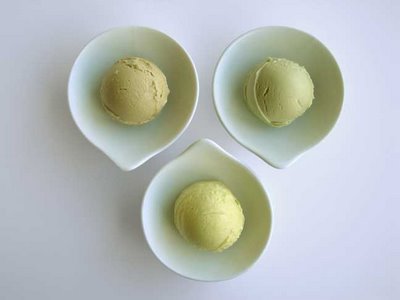
I was shopping at Whole Foods the other day when I came across a heap of glowing Meyer lemons. I haven't come across Meyer lemons that often and knew that I would be making dessert for a dinner this weekend; so, I decided to buy a bunch. When I got home, I went to my pastry books and took out Chez Panisse Desserts by Lindsey Shere and Chez Panisse Fruit by Alice Waters. As Alice Waters notes on the Meyer lemon, “it wasn’t until our long time pastry chef Lindsey Shere started experimenting with them that our proselytization began.” Shere has been inspiring chefs and home cooks for years with her wonderful knowledge and her insistence on quality and seasonal ingredients. Armed with inspiration, a recipe and Meyer lemons, I set out to make a lemon dessert. I wanted to make a dessert which really emphasized the flavour and aroma of the Meyer lemon. So I knew it had to be simple and clean. I decided to make a lemon tart with a sherbet and a compote.

Meyer lemon tart with a Meyer lemon sherbet and compote
The crust of the lemon tart was tender and flakey. The filling was tangy without being tart and the quenelle of cream helped to further soften the acidity. The candied citrus peel added a nice crisp sweetness. The sherbet was light and lively without being too acidic. The addition of milk in the sherbet recipe helped to mellow it. Lastly, the compote of segmented lemon with lemon sauce helped to give the taster a clear understanding of the taste, texture and tanginess of the Meyer lemon.
Meyer lemon tart
*one pre-baked short crust tart shell
2 Meyer lemons
2 eggs
3 egg yolks
6 Tbsp sugar
2 Tbsp milk
1/4 tsp cornstarch
3 Tbsp unsalted butter
3 Tbsp salted butter
makes 1 3/4 cup tart filling, enough for a 9 inch tart
Grate the peel from the lemons into a small non-corroding bowl. Juice the lemons and strain the juice into the same bowl. Strain out seeds, but force as much as the pulp through the strainer. Beat the eggs and egg yolks with the sugar in a heavy non-corroding saucepan just until mixed. Gradually mix the milk into the cornstarch in a small cup, then add them to the egg mixture – the cornstarch is necessary if the filling is to brown properly when baking. If you do not want to brown the tart, the cornstarch can be omitted. Next stir in the juice mixture: it will look a bit curdled when the juice is added, but will smooth out later. Cut the butter into pieces and add to the mixture. Cook the mixture over low to medium heat, stirring constantly, until it just coats the spoon and is the thickness of crème anglaise. Let it stand 5 minutes to thicken, then whisk slightly to smooth it.
At this point you can pour the filling into a container and keep it in the refrigerator for up to two weeks. In any case it is best to chill the filling before making a tart, but you may also pour it into the pre-baked tart shell without chilling it.
Preheat your oven to 375ºF. Fill the slightly cooled pre-baked shell with filling and bake for 30-35 minutes, or until the top is speckled with dark brown spots and the filling has puffed slightly. Remove from the oven and cool on a rack in its pan. You can also bake the tart just long enough to set the filling, about 15-20 minutes. This will make a smooth, shiny tart.
From Chez Panisse Desserts, by Lindsey Shere
Meyer lemon sherbet
1 1/2 cups sugar
1 1/2 cups water
1 cup Meyer lemon juice
1 Tbsp finely chopped Meyer lemon zest
3/4 cup milk
1 tsp gelatin
2 Tbsp water
makes one quart
In a small saucepan, gently heat the sugar and water until the sugar is dissolved. Pour this syrup into a bowl with the lemon juice. Stir in the zest and milk. In the saucepan, combine the gelatin with the water and let it sit for 5 minutes. Once the gelatin has plumped up, heat it gently until there is no visible graininess. Add the melted gelatin to the lemon mixture and refrigerate. When the sherbet base is cold, freeze it according to the instructions for your ice cream maker.
From Chez Panisse Fruit, by Alice Waters
If you haven’t had Meyer lemons before, pick some up and give them a try. I recommend anything that any one of the Chez Panisse cookbooks suggest with Meyer lemons. I absolutely adore them and I can see why they are popular and often in limited supply. I hope you enjoy!










